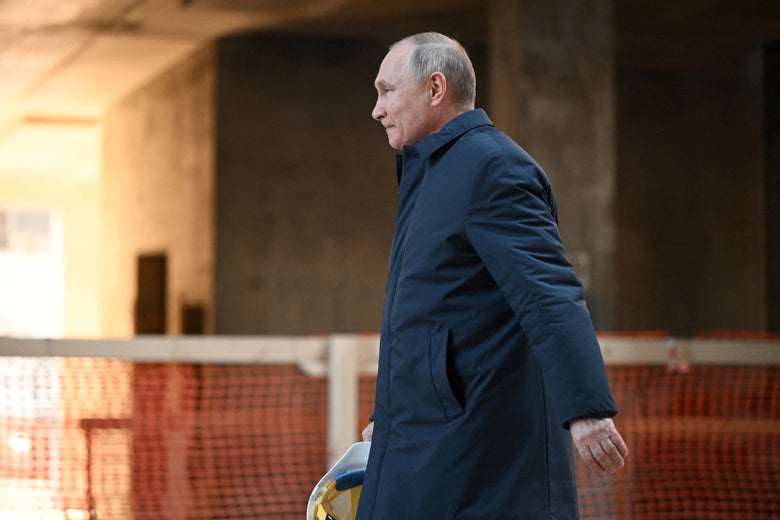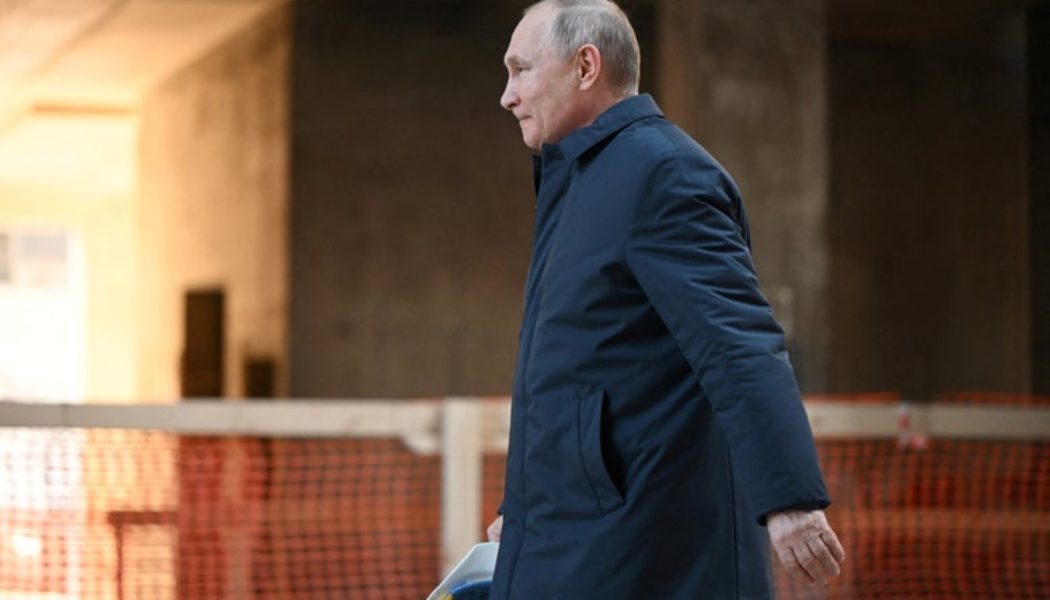
Vladimir Putin has been flaunting his nuclear arsenal since the invasion of Ukraine got underway. He has test-launched several cruise and ballistic missiles, ordered his underlings to up the alert level of Russia’s nuclear weapons, and even threatened to use them if the U.S. or NATO gets involved in the fighting. Is he serious? Might he really go nuclear in order to win this war?
Probably not, with one big caveat: If the U.S. or NATO were to intervene in the Ukraine war directly, sending boots on the ground or dropping bombs from the sky, then Putin might really push a button.
Advertisement
That’s why President Joe Biden and other Western leaders have said they wouldn’t go that far to defend Ukraine. Putin regards Ukraine as part of Russia. He is killing thousands of people, including many of his own soldiers, in an effort to keep it that way. If we fought back directly, we would be in a war with Russia. If Putin thought he couldn’t win that war with conventional arms alone (he’s having a hard enough time against just the Ukrainian army), he might very well escalate to nuclear war. That’s what nuclear weapons are for—not just to deter a nuclear attack by an adversary but also to deter (and, if necessary, tip the course of) a large-scale conventional war.
Advertisement
Advertisement
Advertisement
Advertisement
This isn’t discussed much in public, but it has been an aspect of nuclear war plans—East and West—since the dawn of the Atomic Age. No American president has officially declared that the U.S. would never be the first to use nuclear weapons in a conflict (even though several have privately believed we wouldn’t do so), in part because allies view the “nuclear umbrella”—the promise that we will, if necessary, use our nukes to protect them from attacks by common enemies—as part of America’s security guarantee. When Presidents Ronald Reagan and Mikhail Gorbachev almost agreed to dismantle all of their nuclear weapons at the Reykjavik summit in 1986, the most alarmed parties were America’s NATO allies, who feared that Reagan was folding up the umbrella. When President Barack Obama led a National Security Council meeting to discuss whether the U.S. should adopt a “no-first-use” nuclear policy, a Pentagon official leaked it to the media. Hours later, the Japanese foreign minister came calling to make sure it wasn’t so.
Advertisement
Advertisement
The parallel isn’t precise; Russia doesn’t have many allies in the world, and the allies it once had were really vassals (which is why many of them wanted to join NATO, once the Soviet Union fell apart). But the point is all nuclear powers have thought about actually using nuclear weapons under desperate circumstances. Such scenarios are ingrained in their war plans. Even if the policy is strictly deterrence, the deterrent has to be “credible”: Political leaders have to convince allies, adversaries, and themselves that they would actually use the weapons if some existential line were crossed.
Advertisement
So would Putin drop the bomb if he thought it was necessary to protect his vital interests? Maybe. If he thought that he was about to lose a war to NATO or the United States, unless he took drastic measures? Quite possibly.
Advertisement
Advertisement
Advertisement
Advertisement
Putin didn’t use the word nuclear in his Feb. 24 speech, announcing his invasion of Ukraine, but he did warn that “whoever tries to hinder us” will face “consequences that you have never faced in your history.” This seemed eerily similar to President Donald Trump’s August 2017 warning to North Korea that further threats and missile tests would be “met with fire and fury like the world has never seen”—which itself evoked President Harry Truman’s description of the atom bomb, after it was dropped on Hiroshima, as “a rain of ruin from the air, the like of which has never been seen on this earth.”
In the past few years, Russian military manuals have outlined a strategy of “escalate to de-escalate.” A possible scenario: NATO and Russia are fighting a conventional war; NATO is winning; Russia tries to tip the balance (“escalate”) by firing off a small number of low-yield nuclear weapons, probably against concentrations of NATO troops or munitions. (“Low-yield” is a relative term: The smallest nukes in the U.S. and Russian arsenals are about the same size as the A-bomb that leveled Hiroshima at the end of World War II; most of them are thousands of times more powerful.) The hope would be that the U.S. president would halt the war (“de-escalate”), fearing that if he responded by firing off nuclear weapons, Russia would fire off more. (The Pentagon cited this hypothetical several years ago to make the case for buying new low-yield nuclear weapons, so we could respond to this Russian tactic without escalating the fight too much. Some of these warheads are now loaded on the missiles in the Navy’s Trident submarines.)
Advertisement
Advertisement
Advertisement
Is this scenario a bit loony? Welcome to Nuclear Strategy 201. It all looks loony from a few steps back—but up close, it has a certain logic. And if someone with his finger on the button believes in the logic, well, that’s all it takes to make it real.
Advertisement
Thankfully, it’s not obvious that Putin has done anything concrete since invading Ukraine to put this nuclear option on the table. On Feb. 27, Putin ordered his defense minister and chief of the Russian army’s general staff “to transfer the army’s deterrence forces”—meaning its nuclear arsenal—“to a special mode of combat duty.”
It wasn’t clear what he meant. The Russian nuclear arsenal has four levels of alert, just as the U.S. arsenal has five. But John Pike, director of GlobalSecurity.org, told me on Monday that Putin’s phrase didn’t correspond to any of those levels. It could mean, he speculated, that Russia was sending more nuclear-missile-carrying submarines out to sea or placing more bombers on airborne alert or mobilizing its short-range nuclear weapons in western Russia. But U.S. officials say no such movements have been detected.
Advertisement
In any case, a senior defense official responded to Putin’s so-called nuclear alert just the way that an official should have—calmly, telling reporters, “We remain confident in our ability to defend ourselves, and our allies, and our partners, and that includes in the strategic deterrent realm.” U.S. nuclear forces remained on the same level of alert that they always are.
On Tuesday, Russian Defense Minister Sergei Shoigu reported to Putin that he had carried out the order, elaborating that “the duty shifts” at all the nuclear command posts “had begun to carry out combat duty with reinforced personnel.”
That’s it? More people have been sent to the nuclear command posts? Olga Oliker, a former Pentagon analyst who is now director of the International Crisis Group’s Europe and Central Asia program, told me, “It looks like Putin just made this thing up, and now Shoigu had to say he did that thing.”
In other words, Putin was engaging in theatrical saber rattling. Then again, it’s unnerving when a dictator in desperate straits engages in saber rattling, especially when the saber is nuclear-tipped.
Join Our Telegram Group : Salvation & Prosperity







